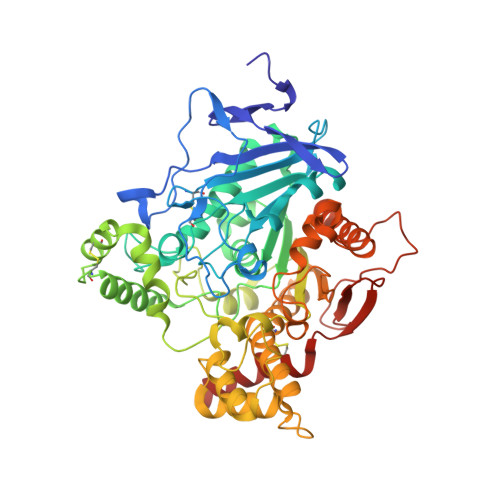Steric and Dynamic Parameters Influencing In Situ Cycloadditions to Form Triazole Inhibitors with Crystalline Acetylcholinesterase.
Bourne, Y., Sharpless, K.B., Taylor, P., Marchot, P.(2016) J Am Chem Soc 138: 1611-1621
- PubMed: 26731630
- DOI: https://doi.org/10.1021/jacs.5b11384
- Primary Citation of Related Structures:
5EHN, 5EHQ, 5EHZ, 5EIA, 5EIE, 5EIH - PubMed Abstract:
Ligand binding sites on acetylcholinesterase (AChE) comprise an active center, at the base of a deep and narrow gorge lined by aromatic residues, and a peripheral site at the gorge entry. These features launched AChE as a reaction vessel for in situ click-chemistry synthesis of high-affinity TZ2PA6 and TZ2PA5 inhibitors, forming a syn-triazole upon cycloaddition within the gorge from alkyne and azide reactants bound at the two sites, respectively. Subsequent crystallographic analyses of AChE complexes with the TZ2PA6 regioisomers demonstrated that syn product association is accompanied by side chain reorganization within the gorge, freezing-in-frame a conformation distinct from an unbound state or anti complex. To correlate inhibitor dimensions with reactivity and explore whether in situ cycloaddition could be accelerated in a concentrated, crystalline template, we developed crystal-soaking procedures and solved structures of AChE complexes with the TZ2PA5 regioisomers and their TZ2/PA5 precursors (2.1-2.7 ? resolution). The structures reveal motions of residue His447 in the active site and, unprecedentedly, residue Tyr341 at the gorge mouth, associated with TZ2 binding and coordinated with other side chain motions in the gorge that may guide AChE toward a transient state favoring syn-triazole formation. Despite precursor binding to crystalline AChE, coupling of rapid electric field fluctuations in the gorge with proper alignments of the azide and alkyne reactants to form the triazole remains a likely limiting step. These observations point to a prime requirement for AChE to interconvert dynamically between sequential conformations to promote favorable electrostatic factors enabling a productive apposition of the reactants for reactivity.
Organizational Affiliation:
Aix-Marseille Universit¨¦, laboratory Architecture et Fonction des Macromol¨¦cules Biologiques, Facult¨¦ des Sciences de Luminy , 13288 Marseille cedex 09, France.

















